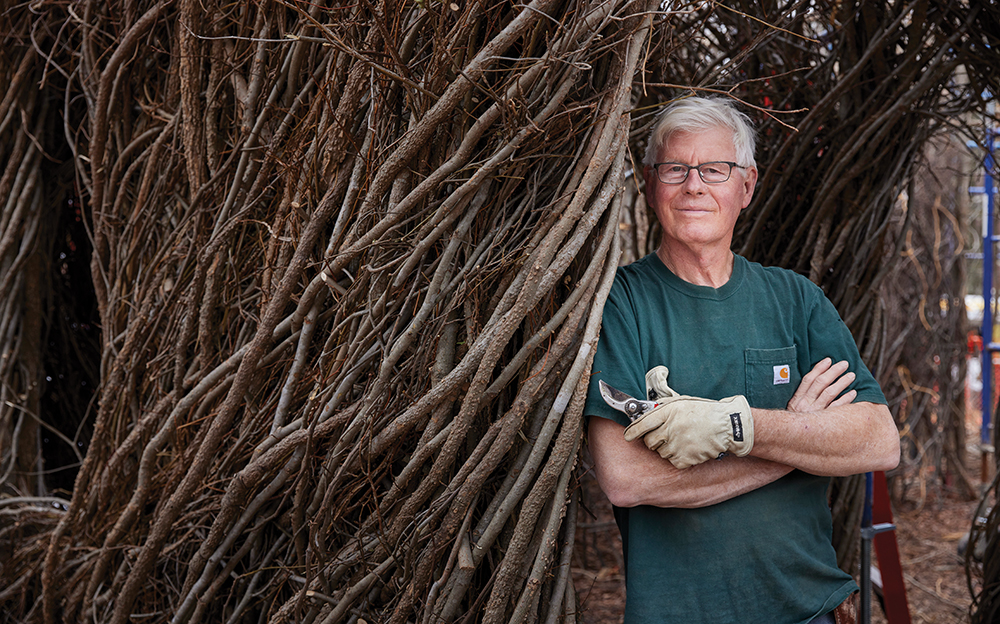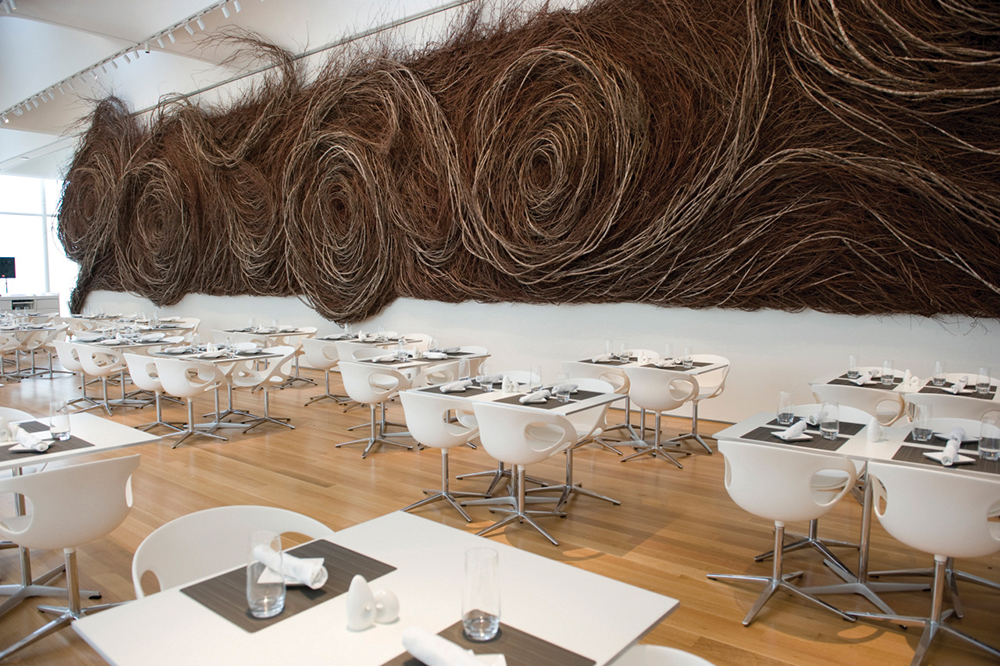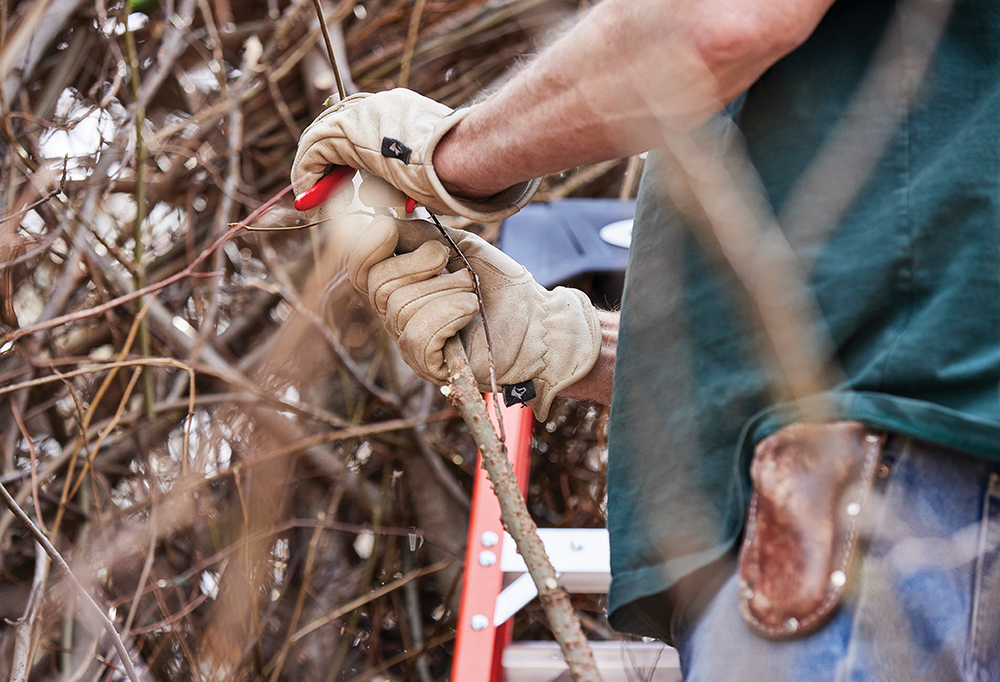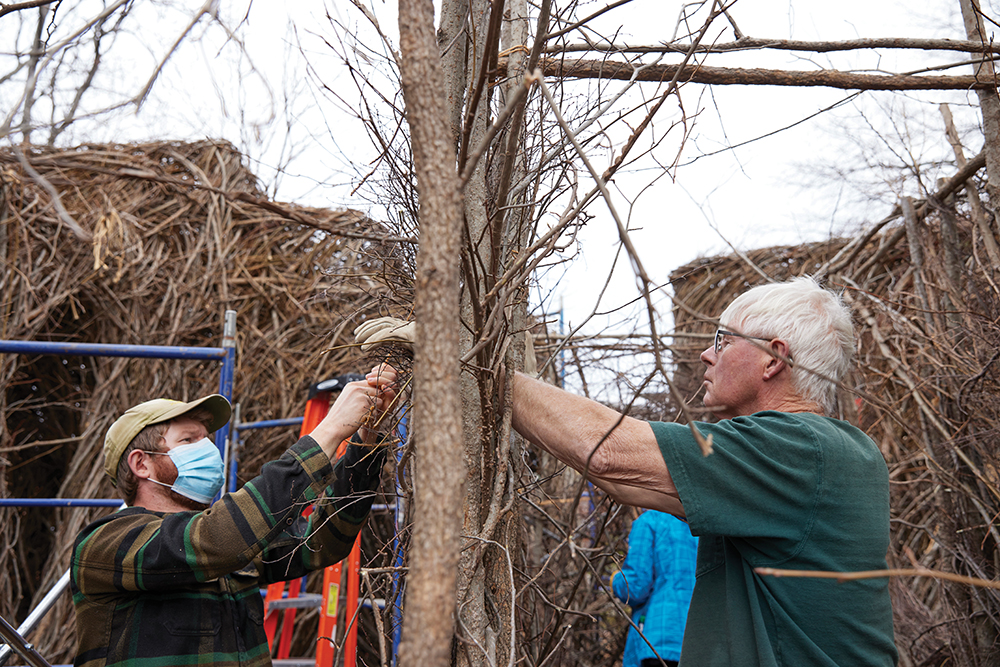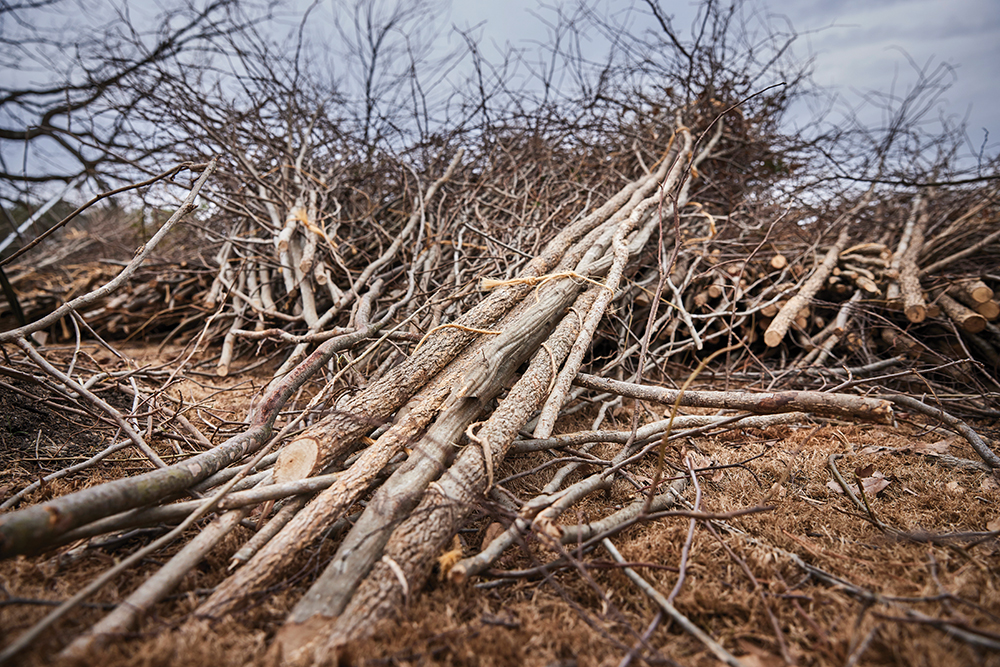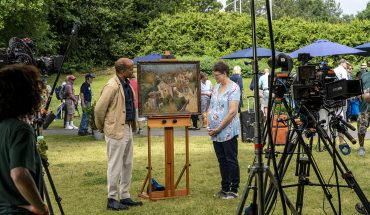Sculptor Patrick Dougherty of Chapel Hill creates inviting, massive sculptures out of sticks and saplings.
by J. Michael Welton | photography by Greg Campbell
Patrick Dougherty weaves whimsical, larger-than-life sculptures out of willow, sweet gum, and birch tree saplings.
The Chapel Hill native builds his finished products mostly outdoors in the natural environment, the overscale forms inviting passersby not to just view them, but to explore within. His ephemeral work has been displayed around the world, gracing gardens and forests in dozens of countries, from Scotland to South Korea.
Around here, you’ve likely encountered Out of the Box on the wall of the North Carolina Museum of Art’s West Building, a 15- by 75-foot-long sculpture of spiraling sticks the museum commissioned in 2009.
As the Thomas Phifer-designed museum was being completed in 2010, Dougherty was in a separate building, testing his saplings for insects, fumigating them, and treating them with a fire retardant. Then he brought them over to the new building to assemble. “I used eye bolts with a cable strung down, and then I wove into that,” he says.
Out of the Box is one-of-a-kind for more than one reason: out of 313 works completed by Dougherty since the early 1980s, only 25 have been designed for interior spaces and most have a temporary lifespan. The NCMA sculpture is the sole project planned from the beginning for permanent display, inside. In fact, most of Dougherty’s willowy sculptures usually live little more than a few years. He deliberately designs them that way. According to the artist: “Outside, the line between trash and treasure is very thin.”
Dougherty manages his clients’ expectations about that when they commission his work. “He says it will have one great year, one good year, and the third will be a pretty good year,” says Aaron Shackelford, director of Georgia Tech Arts in Atlanta, about the school’s new sculpture, A Chip Off the Ol’ Block. After that, Dougherty’s sweet-gum-woven work will be mulched and scattered across the campus. “It can’t look disheveled or it will lose credibility,” Dougherty says.
For three weeks in early January, Dougherty and his son Sam worked at Georgia Tech, up on a hill near the Kendeda Building, a state-of-the-art regenerative structure said to be the Southeast’s most environmentally friendly building. “You walk out the door, and you see it,” Shackelford says of Dougherty’s sculpture. “To Patrick, it was the most likely site.”
Dougherty wants people to interact with his pieces. That might mean walking up and touching them or entering one of the windows or doors that puncture them. “People know sticks from childhood — they remember being kids under a lilac bush or playing in a forest — and these memories are starting points when they look at the sculptures,” Dougherty says. “Then they go inside — and it can be emotional.”
The desired outcome is often a visceral experience — not just for the viewers, but for the hundreds of volunteers who gather, collect, and deliver saplings to one of his sculpture’s sites. They’re usually an integral part of the whole gestalt of Dougherty’s work. In Georgia Tech’s case, volunteers flocked to a community called Serenbe on the Chattahoochee River, in search of saplings to load on a flatbed and deliver to campus.
“I was most worried about the volunteers, because it was 40 degrees and I was concerned that they wouldn’t show up,” says Shackelford. “But when all was said and done, there were 150 students and community volunteers, even though it was cold and we were digging in the mud.”
Completed on January 22, A Chip Off the Ol’ Block consists of four separate structures that Shackelford expects to become a sort of campus land- mark “There will be a lot of graduation photos taken there, plus first-day-of-class pics,” he says.
At Davidson College in Mecklenburg County, Dougherty completed a sculpture on a triangular space near the main library last year. Called Common Ground, the project’s name reflects the community spirit of faculty and students working in unison to make it a reality.
“We got to spend a lot of time together,” says Lia Newman, director and curator of the Van Every/Smith Galleries, a contemporary art space at Davidson. “It was difficult, backbreaking work for three weeks, but he was generous with his time and with the students and community.”
During a visit to Davidson in August 2019, Dougherty looked at a number of sites before deciding on one that would generate the most traffic. By the time the project was underway in January 2020, students, faculty, and members of the ground crew were loading a tractor trailer with saplings from college-owned property. “It was like we could never fill the need — we spent weeks ahead of his visit collecting the material and getting it to the site,” Newman says. “Mostly we were cutting three different-sized requirements, and when he got here, we were still collecting more.”
That February, the Davidson project’s finishing touches slipped in just under the coronavirus wire. “Now we all feel a little more connected because of it,” Newman says. “Today, it’s one thing that people can do during the pandemic.”
The sculpture is a physical bridge between the existing architecture and landscape. “It’s large, almost like a maze, because you go in and out of different spaces,” Newman says. “It’s interactive, and gets people to connect to the archi- tecture around it.”
Alas, like the students mobbing the Georgia Tech sculpture, they won’t have that opportunity forever. Newman and the Davidson ground crew are keeping their eyes on the project and continually assessing its condition.
“All Patrick’s work will go away at some point, so maybe it’s got a year and a half to two-plus years from now,” she says. “He doesn’t like to have the art collapse on itself.”
By the end of April, North Carolina will have one more of Dougherty’s sculptures, on a highly visible open area near the winery at the Biltmore Estate’s Antler Hill Village in Asheville. Parker Andes, Biltmore’s director of horticulture, says that one of the reasons the site works is because it’s an agricultural area — and one of the original owner’s favored spots. “Patrick’s art fits with the horse barn from 1901, a historic area near a log cabin that was George Vanderbilt’s hunting lodge,” he says. “It needed to be away from the house because it would be incongruent with that architecture and the feel of the house.”
Besides, both Andes and Dougherty want the sculpture to be visible and experiential to those who visit the estate. Andes estimates that several hundred thousand people will be interacting with the new sculpture during this spring, summer, and fall.

“We want to give them an experience that will connect with them, where they’ll find a little inspiration, and see the structure, the flow, and the artistry,” he says. “Families will interact, take pictures and maybe some middle schooler or high schooler will say: I could do something like this!”
After much consideration, the Biltmore project’s materials will be shipped in from Dougherty’s favorite source for willow saplings in New York state. But for now, the scope and nature of the Biltmore sculpture is unclear. “When we order material, we don’t know what we’re going to get,” Dougherty says. “The last time, the willows were 8 feet tall, but maybe this time they’ll be 10 feet tall.”
So besides the initial quests for a well-traveled site and the right kind of sticks, there are other questions, like what the work is going to be, and who will help put the sculpture together. “I have to see what my resources are,” he says. “I’ll take some ideas with me, and see what I have then, and make some decisions.”
So besides the initial quests for a well-traveled site and the right kind of sticks, there are other questions, like what the work is going to be, and who will help put the sculpture together. “I have to see what my resources are,” he says. “I’ll take some ideas with me, and see what I have then, and make some decisions.”
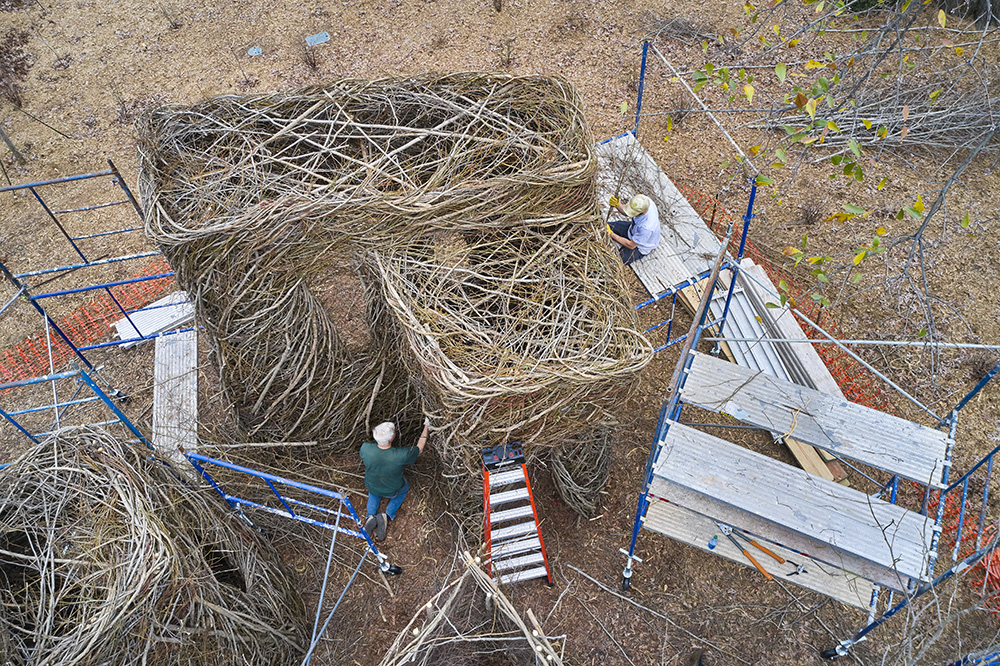
Typically, building the sculptures takes place within a tight time frame. “Your sponsors get tired of you,” Dougherty says. “Three weeks is about all we can do before that happens — they start pulling their hair out. Everybody has got their limits, and by the time we leave, they’re ready for us to go.”
However it turns out, the Biltmore project, too, will be temporary. “It’s completely recyclable,” Andes says. “It’s going to last as long as it’s going to last, and then it’ll be picked up and become mulch for garden beds. It’s truly organic.”

